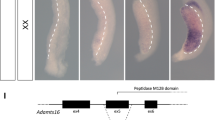Abstract
Defects in the conversion of androstenedione to testosterone in the fetal testes by the enzyme 17β–hydroxysteroid dehydrogenase (17β–HSD) give rise to genetic males with female external genitalia. We have used expression cloning to isolate cDNAs encoding a microsomal 17β–HSD type 3 isozyme that shares 23% sequence identity with other 1 7β–HSD enzymes, uses NADPH as a cofactor, and is expressed predominantly in the testes. The 17βHSD3 gene on chromosome 9q22 contains 11 exons. Four substitution and two splice junction mutations were identified in the 17βHSD3 genes of five unrelated male pseudohermaphrodites. The substitution mutations severely compromised the activity of the 17β–HSD type 3 isozyme.
This is a preview of subscription content, access via your institution
Access options
Subscribe to this journal
Receive 12 print issues and online access
$209.00 per year
only $17.42 per issue
Buy this article
- Purchase on Springer Link
- Instant access to full article PDF
Prices may be subject to local taxes which are calculated during checkout
Similar content being viewed by others
References
Jost, A. Hormonal factors in the sex differentiation of the mammalian foetus. Philos. Trans. Royal Soc. Lond. 259, 119–130 (1970).
Lee, M.L. & Donahoe, P.K. Müllerian inhibiting substance: A gonadal hormone with multiple functions. End. Rev. 14, 152–164 (1993).
Wilson, J.D. Sexual differentiation. A. Rev. Physiol. 40, 279–306 (1978).
Griffin, J.E., McPhaul, M.J., Russell, D.W. & Wilson, J.D. The androgen resistance syndromes: Steroid 5α-reductase 2 deficiency, testicular feminization, and related disorders. in The Metabolic Basis of Inherited Disease (eds Scriver, C.R. et al.) (McGraw-Hill, New York, in the press).
Wilson, J.D., Griffin, J.E. & Russell, D.W. Steroid 5α-reductase 2 deficiency. End. Rev. 14, 577–593 (1993).
New, M.I., White, P.C., Pang, S., Dupont, B. & Speiser, P.W. The adrenal hyperplasias. In The Metabolic Basis of Inherited Disease (eds Scriver, C.R. et al.), 1881–1917 (McGraw-Hill, New York, 1989).
Grumbach, M.M. & Conte, F.A. Disorders of sex differentiation. In Williams Textbook of Endocrinology (eds Wilson, J.D. & Foster, D.W.) 853–951 (W.B. Saunders, Philadelphia, 1992).
Peltoketo, H., Isomaa, V., Mäentausta, O. & Vihko, R. Complete amino acid sequence of human placental 17β-hydroxysteroid dehydrogenase deduced from cDNA. FEBS Lett. 239, 73–77 (1988).
The, V.L. et al. Characterization of cDNAs for human estradiol 17β-dehydrogenase and assignment of the gene to chromosome 17: Evidence for two mRNA species with distinct 5′-termini in human placenta. Molec. Endocrinol. 3, 1301–1309 (1989).
Luu-The, V. et al. Structure of two in tandem human 17β-hydroxysteroid dehydrogenase genes. Molec. Endocrinol. 4, 268–275 (1990).
Wu, L. et al. Expression cloning and characterization of human 17β-hydroxysteroid dehydrogenase type 2, a microsomal enzyme possessing 20α-hydroxysteroid dehydrogenase activity. J. biol. Chem. 268, 12964–12969 (1993).
Andersson, S., Davis, D.L., Dahlbäck, H., Jörnvall, H. & Russell, D.W. Cloning, structure, and expression of the mitochondrial cytochrome P-450 sterol 26-hydroxylase, a bile acid biosynthetic enzyme. J. biol. Chem. 264, 8222–8229 (1989).
Kozak, M. Point mutations define a sequence flanking the AUG initiator codon that modulates translation by eukaryotic ribosomes. Cell 44, 283–292 (1986).
Inano, H., Kawakura, K. & Tamaoki, B.J. Active form of 17 β-hydroxysteroid dehydrogenase of porcine testes. Steroid Biochem. 8, 787–789 (1977).
Inano, H., Tamaoki, B., Hamana, K. & Nakagawa, H.J. Amino acid composition and immunochemical properties of porcine testicular 17β-hydroxysteroid dehydrogenase. Steroid Biochem. 13, 287–295 (1980).
Krozowski, Z. 11β-hydroxysteroid dehydrogenase and the short-chain alcohol dehydrogenase (SCAD) superfamily. Molec. Cell.Endocrinol. 84, C25–C31 (1992).
Bairoch, A. Prosite: a dictionary of sites and patterns in proteins. Nucl. Acids Res. 20, 2013–2018 (1992).
Martel, C. et al. Distribution of 17β-hydroxysteroid dehydrogenase gene expression and activity in rat and human tissues. J. Steroid Biochem. molec. Biol. 41, 597–603 (1992).
Kohn, G., Lasch, E.E., EI Shawwa, R., Litvin, Y. & Rösler, A. Male pseudohermaphroditism due to 17β-hydroxysteroid dehydrogenase deficiency (17βHSD) in a large Arab kinship. Studies on the natural history of the defect. J. ped. Endocrinol. 1, 30–37 (1985).
Akesode, F.A., Meyer, W.J. & Migeon, C.J. Male pseudohermaphroditism with gynaecomastia due to testicular 17-ketosteroid reductase deficiency. Clin. Endocrinol. 7, 443–452 (1977).
Eckstein, B., Cohen, S., Farkas, A. & Rösler, A. The nature of the defect in familial male pseudohermaphroditism in Arabs of Gaza. J. clin.endocrinol. Metab. 68, 477–485 (1989).
Lin, S.-X. et al. Subunit identity of the dimeric 17β-hydroxysteroid dehydrogenase from human placenta. J. biol. Chem. 267, 16182–16187 (1992).
Poutanen, M., Miettinen, M. & Vihko, R. Differential estrogen substrate specificities for transiently expressed human placental 17β-hydroxysteroid dehydrogenase and an endogenous enzyme expressed In cultured COS-m6 cells. Endocrinol. 133, 2639–2644 (1993).
Thigpen, A.E. et al. Tissue distribution and ontogeny of steroid 5α-reductase isozyme expression. J. clin. Invest. 92, 903–910 (1993).
Andersson, S., Berman, D.M., Jenkins, E.P. & Russell, D.W. Deletion of steroid 5α-reductase 2 gene in male pseudohermaphroditism. Nature 354, 159–161 (1991).
Sambrook, J., Fritsch, E.F. & Maniatis, T. In Molecular Cloning: A Laboratory Manual, 2nd edn (Cold Spring Harbor Laboratory Press, New York, 1989).
Thigpen, A.E. et al. Molecular genetics of steroid 5α-reductase deficiency. J. clin. Invest. 90, 799–809 (1992).
Author information
Authors and Affiliations
Rights and permissions
About this article
Cite this article
Geissler, W., Davis, D., Wu, L. et al. Male pseudohermaphroditism caused by mutations of testicular 17β–hydroxysteroid dehydrogenase 3. Nat Genet 7, 34–39 (1994). https://doi.org/10.1038/ng0594-34
Received:
Accepted:
Issue Date:
DOI: https://doi.org/10.1038/ng0594-34
This article is cited by
-
Antioxidants (selenium and garlic) alleviated the adverse effects of tramadol on the reproductive system and oxidative stress markers in male rabbits
Scientific Reports (2022)
-
11-Oxygenated androgens in health and disease
Nature Reviews Endocrinology (2020)
-
17β-hydroxysteroid dehydrogenase type 3 deficiency: female sex assignment and follow-up
Journal of Endocrinological Investigation (2020)
-
Modelling steroidogenesis: a framework model to support hypothesis generation and testing across endocrine studies
BMC Research Notes (2018)
-
Next-generation sequencing reveals genetic landscape in 46, XY disorders of sexual development patients with variable phenotypes
Human Genetics (2018)



